APPLICATION OF SIX SIGMA METHODS IN QUALITY CONTROL OF BILAN LIPID TEST AND CALCULATION OF QUALITY GOAL INDEX RATIO
Main Article Content
Abstract
Objectives: 1. Calculate the Six Sigma values of Bilan lipid test on Cobas-6000 and Cobas-8000 machine systems using Internal Quality Control data. 2. Quality goal index ratio of analytes performed low for sigma for accuracy and precision problem. Materials and methods: Six Sigma values were determined from coefficient of variation (CV%) taken from Internal Quality Control (IQC) results for 3 consecutive months, Bias taken from External Quality Control (EQC) results for 3 consecutive months from July 2021 to September 2021 and Total Allowable Error (TEa) refer to CLIA. If the sigma values are ≥ 6, between 3 and 6, and <3, they are classified as “world-class”, “good” and “unacceptable”, respectively. The quality goal index ratio was calculated based on the Six Sigma values and CV% values of each test. Results: Tests with Sigma>=6 values include Triglyceride, and HDL-C at both levels on Cobas 6000 machine. Tests 4=< Sigma<5 include total Cholesterol and LDL-C at both levels on the Cobas 6000 machine and Triglyceride at both levels on the Cobas 8000 machine. Tests with sigma values <3 include total Cholesterol, HDL-C, and LDL-C at both levels on the Cobas 8000 machine. The QGI on the Cobas 8000 machine < 0.8 indicates the problem that total Cholesterol tests and LDL-C tests are precision. The QGI on the Cobas 8000 >=1.2 indicates the problem that the HDL-C test at both levels is accuracy. Conclusion: The Sigma metrics regularly evaluate the test performance based on the laboratory's available Internal Quality Control and External Quality Control data. Sigma rules can be used to more simply and intuitively choose the quality control strategy.
Article Details
Keywords
QC, TEa, CV, Bias, Six Sigma, QGI
References
2. Westgard JO, Klee GG (2006). Quality management. In: Burtis CA, Ashwood ER, Bruns DE, editors. Tietz textbook of clinical chemistry, 4th ed. Philadelphia: Sauders
3. Westgard JO, Groth T. Power functions for statistical control rules. Clin Chem 1979;25:863-9.
4. Kumar BV, Mohan T. Sigma metrics as a tool for evaluating the performance of internal quality control in a clinical chemistry laboratory. J Lab Physicians. 2018;10:194-199.
5.Westgard JO, Westgard SA (2006). The quality of laboratory testing today: an assessment of sigma metrics for analytic quality using performance data from proficiency testing surveys and the CLIA criteria for acceptable performance, Am J Clin Pathol, 125:343-354.
6.Desirable Biological Variation Database specifications, www.westgard.com/ biodatabase1.htm.
7. Sunil Kumar Nanda, L. R. (2013). Quantitative Application of Sigma Metrics in Medical Biochemistry. Journal of Clinical and Diagnostic Research, 2689.


